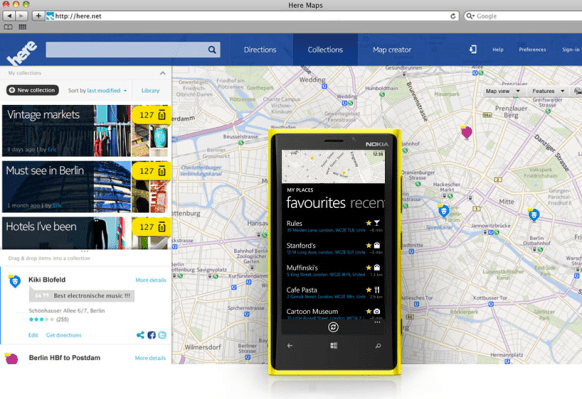Nokia today announced its plan to debut Here, the rebranded, enhanced version of Nokia Maps, on the iOS platform pending Apple’s approval. It will be available as a free download, according to a Nokia press release, and will be based on HTML5, feature offline modes, voice-guided walking directions and built-in public transit guidance, some of which aren’t present in Apple’s native Maps app. I think Apple will welcome Nokia Here with open arms, rather than feel threatened, because iOS presence would help both Nokia and Apple take a shot at Google.
For Nokia, a number of the announcements today were focused on explaining how the company could start to compete with Google more directly as a mapping solution provider. It acquired earthmine, for instance, to build out its 3D street-level imaging, which could help it compete with Google Street View. Other key components of the announcement involve plans to increase its use of data-gathering cars (Google has those, too), and to leverage crowd-sourced information for ongoing improvements to traffic data and map accuracy.
Unlike Apple, which only recently got in to the mapping game, Nokia has been here for years. Nokia Maps has been around in some form or another since 2001. Nokia took Maps over from Gate5 in 2006 via acquisition, and has been improving it ever since. Compare that with Google Maps, which has been under Google’s control since 2004. Google still has a head start, and a massive user pool to draw from, but Nokia is starting from stronger bedrock than Apple was.
Being on iOS as a native app would mean access to a huge number of users that it wouldn’t otherwise be able to attract, which in turn means more data it can mine to improve its maps product. As for what Apple gains, it’s two-fold. First, it can offer its users a native maps app that isn’t just another Band-Aid solution from a company that addresses only one aspect of the problem. Apple needn’t worry too much about Here usurping its own native Maps app in terms of popularity; it retains control over the platform, so once the Here app is no longer necessary as a stop-gap solution, it can easily figure out a reason to get it off said platform.
Second, building up Nokia as a strong mobile maps competitor means giving Google some decent competition while it continues working on its own maps. Google Maps being the ubiquitous, go-to product in the market has the potential to act as a syphon for Android, attracting potential customers away from iOS. If there are strong alternatives to that particular feature elsewhere, regardless of who’s providing them, in the short-term, that’s good for Apple and good for iOS in the long-term.
There’s been little word regarding whether Google will provide a native maps app for iOS, or whether Apple will approve it lately, but Nokia’s stands a much better chance of seeing the light of day. And we’ll be sure to let you know how it stacks up against the competition when it does.
